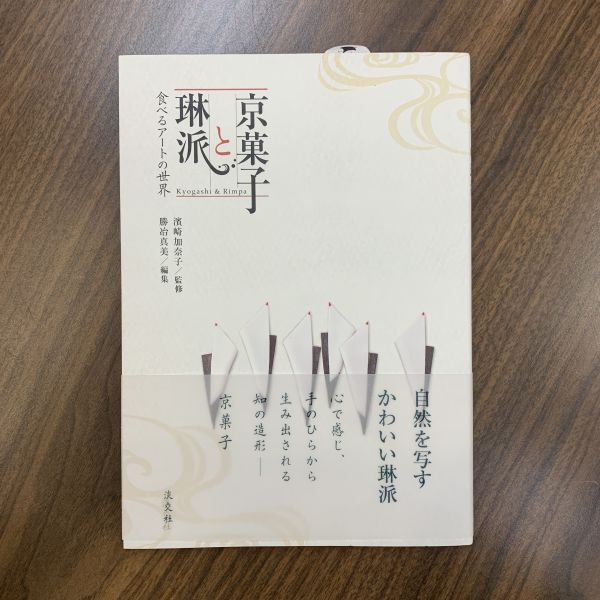商品詳情
《京菓子與琳派》
《京菓子與琳派》是濱崎加奈子所著的一本書,探討京都傳統和菓子(京菓子)與日本的藝術流派「琳派」之間的深刻聯繫。這本書深入分析了琳派藝術對京菓子設計的影響,特別是在色彩、形狀、季節性表現等方面,展示了京菓子如何融合琳派的美學,並將其獨特的視覺語言和文化元素轉化為精緻的甜點藝術。
1. 內容與主題
《京菓子與琳派》這本書不僅是一本關於京菓子的藝術書籍,還是一部關於日本傳統美學的研究之作。書中詳盡介紹了京菓子的歷史與技術,並深入探討了琳派在這些設計中的影響。琳派是17世紀初期在京都興起的日本藝術流派,擁有華麗的色彩、強烈的裝飾性和對自然景象的精緻表現。這些琳派的藝術特徵,深刻地影響了京菓子的視覺設計與製作方法。
書中作者濱崎加奈子以琳派的畫作為出發點,解釋了如何將琳派的裝飾藝術、自然景象、四季變遷等元素巧妙地融入京菓子的設計中,展現出一種既傳統又現代的美學。
2. 京菓子的美學與琳派的影響
京菓子是京都傳統的和菓子,以其精緻的外觀、色彩和造型而著名。京菓子的設計不僅注重其口感和材質的選擇,還注重其外觀的藝術性,特別是在形狀、顏色及裝飾上。琳派藝術的特色之一,就是華麗的色彩使用和對細節的講究,這些特點也影響了京菓子的外觀設計。
濱崎加奈子在書中具體分析了以下幾個方面:
- 色彩與裝飾性:琳派的作品以豐富的色彩和金銀的裝飾著稱,而京菓子也常使用金粉、銀粉等裝飾來提升視覺效果,這與琳派的風格相呼應。
- 自然與季節的表現:琳派畫作中經常表現四季的變化,如梅花、櫻花、紅葉等,而這些元素也在京菓子中經常出現,並且具備了象徵意義,體現了對大自然的敬畏與讚美。
- 精緻的工藝:琳派藝術追求細膩的裝飾效果,京菓子也同樣重視每一個細節的雕刻和呈現,從花朵的花瓣到葉片的紋理,都表現出極致的工藝水準。
3. 京菓子中的琳派元素
書中濱崎加奈子提供了幾個具體的案例,說明琳派如何影響京菓子的設計。例如,她提到著名的琳派畫家尾形光琳的畫作《紅白梅圖屏風》,這幅畫中表現了紅梅和白梅的美麗景象,這樣的梅花設計便常常出現在京菓子的外型中,並且成為代表季節和吉祥寓意的象徵。此外,琳派的金色裝飾和細膩的筆觸也對京菓子的設計起到了啟發作用,金粉和銀粉的使用,讓京菓子呈現出如畫作般的華麗效果。
4. 書籍結構與內容安排
《京菓子與琳派》有條理地分為數個章節,每一章都圍繞京菓子與琳派之間的關聯進行詳細探討。書的結構大致如下:
- 第1章:京菓子的歷史與發展
- 第2章:琳派的藝術風格與特色
- 第3章:琳派藝術對京菓子設計的影響
- 第4章:具體案例分析:京菓子中的琳派元素
- 第5章:當代京菓子與琳派的融合與發展
這些章節從藝術理論到具體的設計分析,將京菓子與琳派藝術的融合過程呈現得淋漓盡致。
5. 結語
《京菓子與琳派》是一本深入剖析京菓子與琳派之間關係的學術著作,也是一本了解日本傳統美學與藝術的絕佳讀物。濱崎加奈子的研究不僅為和菓子愛好者提供了全新的視角,也讓讀者能夠更深刻地理解日本文化中的美學價值。這本書的意義不僅限於和菓子或琳派的研究領域,也為任何對日本藝術和文化感興趣的讀者提供了豐富的素材和啟發。
對於熱愛日本藝術、和菓子和琳派文化的讀者來說,《京菓子與琳派》無疑是一本值得閱讀的著作。
———————————————————————————————————————————————————
『京菓子と琳派』
『京菓子と琳派』は、濱崎加奈子による著作で、京都の伝統的な和菓子(京菓子)と、日本の絵画流派「琳派」の深い関係を探る本です。この本では、琳派の美学が京菓子のデザインに与えた影響について、色彩、形、季節感などの観点から詳細に解説しています。濱崎加奈子は、京菓子の美学と琳派の装飾的な要素がいかに融合しているのかを明らかにし、両者の関係を深く掘り下げています。
1. 内容とテーマ
『京菓子と琳派』は、京菓子の歴史や技術を紹介するとともに、琳派の影響を受けた和菓子のデザインについて詳述しています。琳派は17世紀初めに京都で生まれた日本の絵画流派で、鮮やかな色使いや装飾的な表現が特徴です。琳派の美学は、京菓子のデザインにも深く影響を与え、色彩や形状、季節感などにその影響が現れています。
この本では、琳派の画作がどのように京菓子に反映され、和菓子の中でどのように形を変えたのかを探求しています。濱崎加奈子は、琳派の絵画が持つ華やかな装飾や自然の美を、京菓子のデザインにどう生かしたのかを考察しています。
2. 京菓子の美学と琳派の影響
京菓子は、京都の伝統的な和菓子で、色彩豊かな美しいデザインが特徴です。京菓子のデザインは、ただ食べるためだけでなく、視覚的にも楽しむことを重視しており、琳派の絵画に見られるような華やかで装飾的な要素を多く取り入れています。
本書では以下の点について詳しく述べています:
- 色彩と装飾性:琳派の絵画に見られる鮮やかな色使いや金銀の装飾が、京菓子にも取り入れられています。例えば、金粉や銀粉を使った装飾が、京菓子に華やかさを加えています。
- 自然と季節の表現:琳派の絵画には、四季折々の自然の美が表現されており、梅、桜、紅葉などが描かれます。同じように、京菓子でも季節ごとの花や景色がデザインに反映され、自然との調和が大切にされています。
- 精緻な工芸:琳派の絵画が持つ精緻な装飾性や細部へのこだわりが、京菓子にも影響を与えています。京菓子もまた、花や葉の形状、色合いに細心の注意を払い、芸術的な美しさを追求しています。
3. 京菓子における琳派の要素
濱崎加奈子は、具体的な京菓子の例を挙げて、琳派の美学がどのように和菓子に反映されたかを説明しています。例えば、尾形光琳の有名な『紅白梅図屏風』に描かれた梅の花のデザインが、京菓子に取り入れられることが多くあります。また、琳派の金銀の使用や装飾的な線が、京菓子にも影響を与え、豪華で華やかな印象を与える和菓子が作られています。
4. 書籍の構成と内容
『京菓子と琳派』は、京菓子と琳派の関係を詳細に解説するために、以下のような章立てで構成されています:
- 第1章:京菓子の歴史と発展
- 第2章:琳派の芸術スタイルと特徴
- 第3章:琳派が京菓子デザインに与えた影響
- 第4章:具体的な京菓子の例と琳派の関連
- 第5章:現代における京菓子と琳派の融合
各章で、琳派の芸術がどのように京菓子のデザインに影響を与え、また京菓子がどのように琳派の美学を反映しているのかを深く掘り下げています。
5. 結論
『京菓子と琳派』は、京菓子と琳派の美学がどのように交わり、互いに影響を与え合っているかを学ぶための貴重な資料です。和菓子のデザインにおける琳派の影響を理解することで、日本の伝統的な美学をより深く理解できる本書は、和菓子愛好者や美術ファンだけでなく、日本文化に興味を持つすべての読者にとって非常に有益な一冊です。
濱崎加奈子のこの書籍は、京菓子と琳派の美学を結びつけ、両者の深い関係を浮き彫りにするものとして、多くの読者に新たな視点を提供することでしょう。
———————————————————————————————————————————————————
"Kyogashi and Rinpa" by Kanako Hamasaki
"Kyogashi and Rinpa" is a book by Kanako Hamasaki that explores the deep connection between Kyoto's traditional sweets (kyogashi) and the Japanese painting school known as Rinpa. The book delves into the influence of Rinpa aesthetics on the design of kyogashi, focusing on aspects such as color, form, and seasonal representation, showing how Rinpa's artistic elements have been incorporated into the art of Japanese sweets. Kanako Hamasaki, a scholar specializing in both Japanese sweets and art, clarifies the intricate relationship between these two aspects of traditional Japanese culture.
1. Content and Theme
"Kyogashi and Rinpa" is not just an art book about kyogashi; it is also a scholarly exploration of traditional Japanese aesthetics. It introduces the history and techniques of kyogashi while examining how Rinpa's influence permeates the design of these sweets. Rinpa is a Japanese painting school that emerged in Kyoto in the early 17th century, known for its vivid colors, decorative style, and refined representations of nature. The aesthetic qualities of Rinpa have profoundly shaped the design of kyogashi, especially in terms of color usage, form, and seasonal motifs.
This book investigates how Rinpa's paintings have influenced the visual design of kyogashi, and how these sweets have adapted and transformed elements of Rinpa's style to create a unique form of edible art.
2. The Aesthetics of Kyogashi and the Influence of Rinpa
Kyogashi is a traditional style of Japanese confectionery from Kyoto, known for its beautiful and intricate designs. The artistry in kyogashi is not just focused on taste and texture, but also on the visual appeal of the sweets, emphasizing color, shape, and decoration. Rinpa's characteristic use of rich colors and ornamental designs has had a direct impact on the aesthetic choices seen in kyogashi.
The book discusses the following points in detail:
- Color and Decoration: Rinpa’s art is renowned for its vibrant color palettes and the use of gold and silver leaf. This decorative style is echoed in the design of kyogashi, where gold powder and silver accents are often used to enhance the sweets' visual appeal.
- Nature and Seasonal Expression: Rinpa paintings frequently depict the beauty of the seasons, such as plum blossoms, cherry blossoms, and autumn leaves. Similarly, kyogashi designs often reflect the changing seasons, using natural elements like flowers and foliage to symbolize various times of the year.
- Delicate Craftsmanship: Rinpa is known for its attention to detail and decorative intricacy. This sensibility is mirrored in kyogashi, which emphasizes meticulous craftsmanship in the shaping of flowers, leaves, and other elements, showcasing an appreciation for fine details.
3. Rinpa Elements in Kyogashi
Kanako Hamasaki provides several specific examples of how Rinpa’s influence can be seen in kyogashi. For example, the famous "Red and White Plum Blossom Screen" by Ogata Kōrin, a representative work of Rinpa, has inspired the design of kyogashi featuring plum blossoms. The delicate, stylized rendering of flowers and the use of gold and silver in the painting are reflected in kyogashi designs, creating sweets that resemble fine art in their appearance.
Additionally, Rinpa's characteristic use of gold and silver accents and its decorative lines have influenced the design of kyogashi, giving the sweets a luxurious, visually rich quality.
4. Structure and Content of the Book
"Kyogashi and Rinpa" is structured in a way that thoroughly explores the relationship between kyogashi and Rinpa. The book is divided into several chapters that cover various aspects of the two art forms. The structure is roughly as follows:
- Chapter 1: The History and Development of Kyogashi
- Chapter 2: The Art Style and Characteristics of Rinpa
- Chapter 3: The Influence of Rinpa on Kyogashi Design
- Chapter 4: Specific Examples: Rinpa Elements in Kyogashi
- Chapter 5: The Fusion of Kyogashi and Rinpa in Contemporary Times
Each chapter addresses the complex ways in which Rinpa’s art has influenced the design of kyogashi, from theoretical discussions to concrete design examples.
5. Conclusion
"Kyogashi and Rinpa" is an invaluable resource for understanding the intersection of kyogashi and Rinpa aesthetics. It provides insight into how the decorative elements and seasonal themes of Rinpa have shaped the visual language of kyogashi, enriching our appreciation for both Japanese confectionery and art. The book is essential reading not only for those interested in traditional Japanese sweets but also for those fascinated by Japanese art and culture as a whole.
Kanako Hamasaki’s work offers a fresh perspective on how these two cultural elements—kyogashi and Rinpa—interact, providing readers with a deeper understanding of Japan's artistic traditions. This book is an important contribution to the study of Japanese aesthetics and is a must-read for anyone interested in the intersection of art, culture, and craftsmanship.



